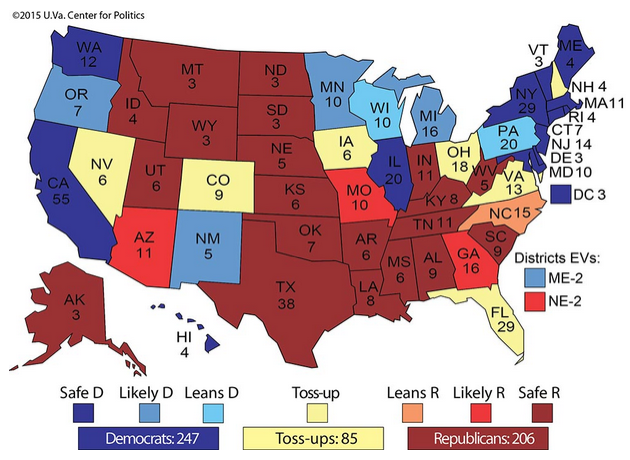Last week a trio of political scientists published their first 2016 Electoral College projections in Politico, and they admit to a lack of surprises: “This map feels like déjà vu: It’s effectively the same map we featured for much of the 2012 cycle.”
It’s another sign of our polarized, stuck-in-a-rut politics. The Politico map shows zero evidence of change, and I can see nothing that reflects the results of the 2014 midterm elections—perhaps because the analysts have concluded that voter turnout in presidential years is so different as to be incomparable. The headline of the Politico article, which I suspect is stronger than the authors intended, is “The 2016 Results We Can Already Predict.” They write that the map “unmistakably suggests the Democratic nominee should start the election as at least a marginal Electoral College favorite over his or (probably) her Republican rival…. Assuming the lean, likely, and safe Democratic states remain loyal to the party, the nominee need only win 23 of the 85 toss-up electoral votes.”*
*The states that at least lean Democratic on the Politico map are: California, Connecticut, Delaware, the District of Columbia, Hawaii, Illinois, Maine, Maryland, Massachusetts, Michigan, Minnesota, New Jersey, New Mexico, New York, Oregon, Pennsylvania, Rhode Island, Vermont, Washington, and Wisconsin. All except New Mexico have voted Democratic for at least the past six elections.
FiveThirtyEight.com’s Nate Silver does not like this kind of thinking at all. “There Is No ‘Blue Wall’,” he declared Tuesday.“Many pundits, ignoring the lessons of history, claim the ‘blue wall’ or some close variation of it puts the Democratic nominee (likely Hillary Clinton) at a substantial advantage for 2016. The error that these commentators are making is in attributing the Democrats’ recent run of success to the Electoral College…. If you see analysts talking about the “blue wall,” all they’re really saying is that Democrats have won a bunch of presidential elections lately — an obvious fact that probably doesn’t have much predictive power for what will happen this time around.”
Silver is correct, but not as correct as he thinks he is. I don’t think many analysts attribute the recent Democratic wins to the technicalities or quirks of the Electoral College. There’s always a chance that the Electoral College could give the presidency to the loser of the popular vote, no matter what the party. The system favored Republican George W. Bush, after all, and it’s easy to imagine the same thing happening in 2016: Hillary Clinton could win the popular vote thanks to huge margins in states like California and New York but lose the Electoral College because of narrow losses in Florida and Ohio.
The Blue Wall is not about Electoral College rules, it’s about the Democrats consistently winning a group of states with a coalition of big-city and educated-suburb votes. (For example, in Pennsylvania, the suburban counties of Bucks, Delaware, and Montgomery all voted Republican in every election from 1968 through 1988, then voted Democratic in every election from 1992 through 2012.) The Blue Wall is a description of a winning formula from the past two decades, not a prediction of electoral outcomes stretching as far as the eye can see. The wall can be knocked down if the Republicans can figure out to expand their appeal.
I’d leave it at that, but I’m puzzled that Silver doesn’t take into account the stickiness of the current Electoral College map. Since Bill Clinton was elected in 1992, the frequency of states switching parties from one election to the next has been unusually low. Forty states have supported the same party for at least the past four elections, and 31 states have supported the same party for at least the past six elections. Only two states flipped in the close 2012 election (Indiana and North Carolina went back to the Republican column after narrowly supporting Obama in 2008), which is the lowest number since 1888, when there were only 38 states.
There have been a total of 14 switches over the past three elections, the lowest since the 12 switches from 1884 through 1892. As the chart below shows, we have settled into a rut after a 20th century full of wide Electoral College swings between the Democrats and Republicans. (The biggest swing came in 1968, when Democrat Hubert Humphrey lost 35 states that had gone for Democrat Lyndon Johnson four years earlier.)

The number of closely contested states has also been low in recent elections. Though Barack Obama beat Mitt Romney by 3.7 points nationally, the candidates were separated by less than 5 points in only four states (Florida, Ohio, and Virginia, which went for Obama, and North Carolina, which went for Romney.) This is a lower number than in any competitive race since World War II. In the 1960 Kennedy-Nixon race, 20 states had margins below five points; in the 1968 Nixon-Humphrey-Wallace race, the number was 13; in the 1975 Carter-Ford race, the number was 20; and in the 2000 Bush-Gore race, the number was 12. Even in competitive national races, the number of “battleground” states is shrinking.
Another data point: Of the 14 party switches in the past three elections, 10 were foreshadowed by close results in the previous elections. For example, Obama’s capture of Ohio in 2008 was preceded by a 2.1-point win for Bush in 2004, and Romney’s recapture of North Carolina in 2012 was preceded by a tiny 0.3-point win for Obama in 2008. It has become increasingly rare for states to “flip” without plenty of warning.
None of this necessarily means a Democratic edge in 2016. The Blue Wall can be breached. But I think the chances of a massive shift in the Electoral College, of the kind that gave Ronald Reagan a landslide win in 1980, are slim to none. Even if economic conditions, a foreign-policy issue, or even a scandal nudges the electorate toward one party or the other, the recent stickiness in the Electoral College isn’t going to vanish that easily.








